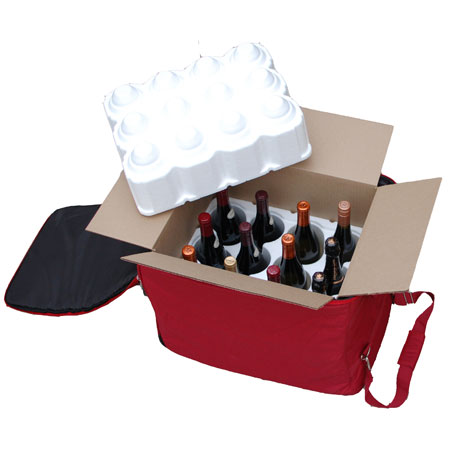- Contact usFR +33 450 872 109 US/CA +1 (646) 233-1354
- - Newsletter
- - Follow us





-

Home > Articles and tour tips > Taking European Wine Home
19-02-2019

You do not have to be a wine connoisseur to appreciate European wine. Whether you are visiting wine estates on your trip or not, we highly recommend you make the most of your opportunity to taste French, Italian, Spanish and/or Swiss wines. (Especially Swiss since 95% of their wine production is consumed within their borders!) A number of our clients have asked us for advice regarding buying wine, which is the first half of this post. The second half looks at taking wine on intercontinental flights, helpful for our American clients!
To purchase wine in Europe you have three options:

Getting it from Europe to your home (United States)
Did you love a bottle of wine so much that you want to take it home? Or better yet buy a whole case? The simplest way (and likely the cheapest way) to bring wine home with you from France is to literally bring it with you. US Customs allows one liter per person to enter duty-free; after that, you may have to pay duty (about $1-3 per gallon). We say “may” because we often hear stories of travelers not having to pay duty on their wine. There is no federal limit to how much wine one person can import but bringing too much can raise suspicions that you are using it for commercial purposes (a federal permit is needed to import alcohol for commercial – or resale- purposes). The general rule of thumb is that one case or less per person can be considered “personal” but there have been travelers who have gotten away with more. Your wine will be assessed at your port of entry, where it will be decided if it is subject to duty and Federal excise taxes. There are 329 US ports of entry; to find yours, check an online listing.
Before traveling with wine, make sure you check with your airline on their regulations regarding wine travel, as some airlines are very strict. We have had clients successfully use products made specifically for carrying wine, such as the Wine Check (also check out https://www.iwawine.com/wine-accessories-iwa/wine-luggage/luggage).

The Wine Check, used to carry wine while traveling.
(N.d. Photograph. IWA WinWeb. 17 Oct 2013.
The difficulty with regards to bringing wine into the US lies in the power of state laws. We highly recommend you familiarize yourself with your own state’s regulations. Usually, state regulations apply to residents of a state, but it’s possible for regulations to change. We recommend double checking the regulations of your port of entry while you are at it.
If you don’t want to carry your wine with you, about half of all US states allow you to ship it to your home. There are a number of specifications necessary for your shipment. It must be labeled as wine and you must have the correct customs documentation. FedEx, for example, provides this shipment service, but only from properly licensed sellers. Most vineyards and wine estates will not ship directly to your home in the US, but many do ship to businesses in the US. If you love a wine you try at an estate, do not hesitate to ask if they ship to any businesses in your state– you might be surprised to find out you can purchase it near your home! If you want to ship wine home, our recommendation is to purchase from a wine merchant. Most wine merchants will ship to the US for you and they are familiar with the process. That being said, their abilities to ship to your home depend entirely on the regulations of your state. US Customs and Border Protection (CBP) will enforce the regulations of the state in which your wine first enters the US (the wine’s port of entry) unless you specify to your shipper that you want your goods sent “in bond” through the port of arrival to a port in your state of residence (assuming these are two different states). Then, CBP will enforce the rules of the state to which your goods have been sent “in bond” rather than the rules of the state where they first arrived. This is important if you are abiding by your own state’s regulations.
The process of shipping wine can save you the trouble of traveling with and carrying wine but it could take a month or more to be delivered. If you choose this method, you will not have to pay VAT (French Consumption tax, 20%) on your wine but you are subject to US taxes and duty the US CBP deems appropriate upon arrival (usually quite low compared to the value of the wine). To give you an example of shipping cost, Badie Vins et Spiritueux in Bordeaux estimates that shipping 12 bottles of wine to the US costs around 266 euros.
Overall, carrying your wine with you is likely the least expensive solution to bringing wine home. But of course, if you don’t want to actually have to carry the wine with you while traveling or flying, shipping can be worth the cost. No matter which method you choose, it is key to look up the regulations of your state.
Enjoy the wine, enjoy the travel, and cheers from Cyclomundo!
Getting to Portugal: Lisbon and Porto
Alsace (6)
Andalusia (7)
Annecy (3)
Apulia (4)
Avignon (2)
Brittany (3)
Catalonia (6)
Corsica (3)
Cycling tips (19)
Dolomites (3)
Emilia-Romagna (2)
Events (7)
France (35)
French Alps (12)
General (68)
Getting there (16)
Girona (1)
Ile-de-France (2)
Italy (17)
La Rioja (3)
Languedoc (4)
Loire Valley (5)
Madrid (2)
Normandy (7)
Our Bikes (5)
Piedmont (4)
Portugal (1)
Provence (11)
Pyrenees (3)
Sicily (2)
Spain (15)
Switzerland (8)
Travel tips (23)
Tuscany (3)
Uncategorized (0)
Veneto (6)